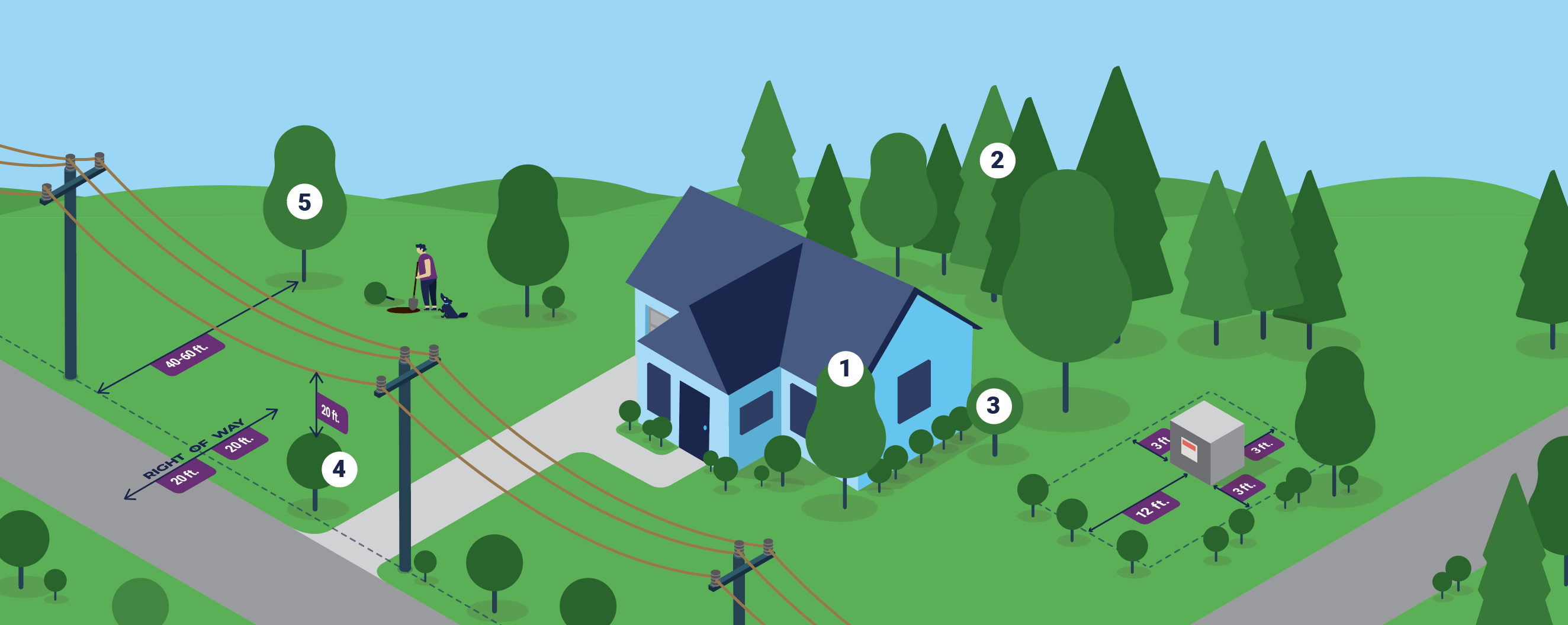Right Tree Right Place
Improve your home. Help the environment.
There are many benefits that come with having trees on your property - shade, beauty, windbreak, privacy, cleaner air, less noise, less glare, and higher property values to name a few. But the key to these benefits is to select the right tree and plant it in the right place. The right tree in the right place not only ensures a lifetime of satisfaction, but it also keeps maintenance costs low.
Improving reliability with intentionality
MTE is constantly working to prevent outages or service disruptions before they occur. Our team of certified arborists work tirelessly to maintain our rights-of-way by identifying potentially damaging trees and vegetation before they come into contact with our electric system. Their work helps ensure the reliability of our grid for our members.
In addition to maintaining the rights-of-way, our vegetation management team also works with members and the community to improve awareness and education about which trees to plant near electrical equipment. By planting the right tree in the right place, our members can help us reduce vegetation-related outages, improve their local environment, and reduce the cooperative costs related to tree pruning.
Wrong trees in the wrong places
Unfortunately, there are still miles of line with the wrong trees in the wrong places. These trees and vegetation can lead to increased power outages which in turn impact overall reliability. No one likes a power outage, particularly when it can be avoided. That's why we're working with members, local businesses, communities, and cities to either prune or replace these trees over time.
Church Street / Hwy 231 toward Shelbyville in Murfreesboro
- When
- Anticipated Start Date: June 20
- Anticipated Completion Date: June 30
- Where
- Northbound lanes along the Indian Hills Golf Course starting near the Bojangles through Warrior Drive
- What
- MTE is working with Indian Hills Golf Course to remove around 50 trees that are growing into the powerlines and causing safety and reliability issues. While removing those trees, MTE is working with the golf course management to plant almost 100 trees and make other landscape improvements to create safer, reliable, and environmentally friendly rights-of-way.
For additional questions or more information, please reach out to our Vegetation Management team using the form below.
The Wrong Way
Incorrectly planting trees on the property has a negative impact on the benefits and aesthetics of your landscaping. Planting large-growing trees under utility lines often means disfigured trees in later years because they must be trimmed to prevent outages. Properly planting trees, however, can bring natural beauty to yards, shade, and reduction of energy usage. For example, large evergreens too close to the house on the south side can block warming winter sunlight, resulting in higher heating costs during cold weather.
The Right Way
Carefully plan where and why you plant trees on your property. To avoid trees being pruned away from power lines, plant short flowering trees to prevent a clash with overhead utility lines. If you'd like to know which trees you can plant, check out the latest list of approved trees for your ROW here.
For energy efficiency, large deciduous trees on the southeast, southwest, and west can provide cooling shade in summer, but they should be located where low winter sunlight is not obstructed. Evergreens planted on the north side can serve as wind breaks in the winter. Our Vegetation Management Specialists can advise members on ways trees can be used to help with home comfort and energy savings.
Factors to Consider Before Planting
- The tree’s purpose affects the suitability of different species, whether used for shade, aesthetic beauty, wind protection, or other purposes.
- The size and location of the tree, including space for roots and branches, affects the decision on which species to plant.
- You should also consider the width and depth of the root system. Trees with deep root systems can stand up to severe weather conditions while wide root systems should be placed away from structures, foundations, and plumbing systems to prevent damage.
Benefits of the Right Tree in the Right Place
- Deciduous trees are best used on the south and west sides of your home to provide cooling shade in summer and warming sunlight in the winter.
- Evergreens planted on the north side can become a natural windbreak from cold winter winds.
- Shorter trees can provide soil stability and beauty in your landscaping.
- Consider how tall your tree will be when mature and how wide the root structure will become. For example, certain types of short flowering trees don’t interfere with the electric system because their mature height is still 15 feet below the power lines. You will also need to make sure the base of the tree is planted 15-20 feet from the centerline of the ROW.
- Plant large trees at least 40-60 feet away from the ROW to reduce the need for pruning.

If you need help picking a type of tree for your yard, MTE has compiled a list of trees recommended for the ROW that won’t interfere with power lines. You can view the recommended tree list by downloading the list.
MTE is proud to be a Treeline USA accredited electric utility.
That means our team of highly trained and certified arborists work to prevent outages caused by trees and vegetation while also ensuring a better environment along our rights-of-way. If you have a question about the trees, plants, or the environment near our electric system, please reach out to our vegetation management team.
Cannon
Ryan Haley
Rutherford
Bryon Smith
Murfreesboro City
Ethan Weibrecht
Williamson
Michael Johnson
Wilson
Jeremy Goldsby





